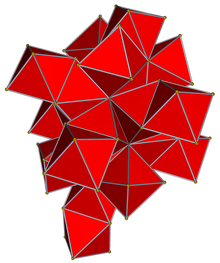This article may require cleanup to meet Wikipedia's quality standards. The specific problem is: Excessive explanatory footnotes, some of which include other explanatory footnotes, which include other explanatory footnotes, and so on. Linearize by trimming for brevity, inserting into main text, or spawning subarticle(s). (March 2024) |
| 24-cell | |
|---|---|
 Schlegel diagram (vertices and edges) | |
| Type | Convex regular 4-polytope |
| Schläfli symbol | {3,4,3} r{3,3,4} = {31,1,1} = |
| Coxeter diagram | |
| Cells | 24 {3,4} |
| Faces | 96 {3} |
| Edges | 96 |
| Vertices | 24 |
| Vertex figure | Cube |
| Petrie polygon | dodecagon |
| Coxeter group | F4, [3,4,3], order 1152 B4, [4,3,3], order 384 D4, [31,1,1], order 192 |
| Dual | Self-dual |
| Properties | convex, isogonal, isotoxal, isohedral |
| Uniform index | 22 |

In four-dimensional geometry, the 24-cell is the convex regular 4-polytope[1] (four-dimensional analogue of a Platonic solid) with Schläfli symbol {3,4,3}. It is also called C24, or the icositetrachoron,[2] octaplex (short for "octahedral complex"), icosatetrahedroid,[3] octacube, hyper-diamond or polyoctahedron, being constructed of octahedral cells.
The boundary of the 24-cell is composed of 24 octahedral cells with six meeting at each vertex, and three at each edge. Together they have 96 triangular faces, 96 edges, and 24 vertices. The vertex figure is a cube. The 24-cell is self-dual.[a] The 24-cell and the tesseract are the only convex regular 4-polytopes in which the edge length equals the radius.[b]
The 24-cell does not have a regular analogue in three dimensions or any other number of dimensions, either below or above.[4] It is the only one of the six convex regular 4-polytopes which is not the analogue of one of the five Platonic solids. However, it can be seen as the analogue of a pair of irregular solids: the cuboctahedron and its dual the rhombic dodecahedron.[5]
Translated copies of the 24-cell can tesselate four-dimensional space face-to-face, forming the 24-cell honeycomb. As a polytope that can tile by translation, the 24-cell is an example of a parallelotope, the simplest one that is not also a zonotope.[6]
- ^ Coxeter 1973, p. 118, Chapter VII: Ordinary Polytopes in Higher Space.
- ^ Johnson 2018, p. 249, 11.5.
- ^ Ghyka 1977, p. 68.
- ^ Coxeter 1973, p. 289, Epilogue; "Another peculiarity of four-dimensional space is the occurrence of the 24-cell {3,4,3}, which stands quite alone, having no analogue above or below."
- ^ Coxeter 1995, p. 25, (Paper 3) Two aspects of the regular 24-cell in four dimensions.
- ^ Coxeter 1968, p. 70, §4.12 The Classification of Zonohedra.
Cite error: There are <ref group=lower-alpha> tags or {{efn}} templates on this page, but the references will not show without a {{reflist|group=lower-alpha}} template or {{notelist}} template (see the help page).

